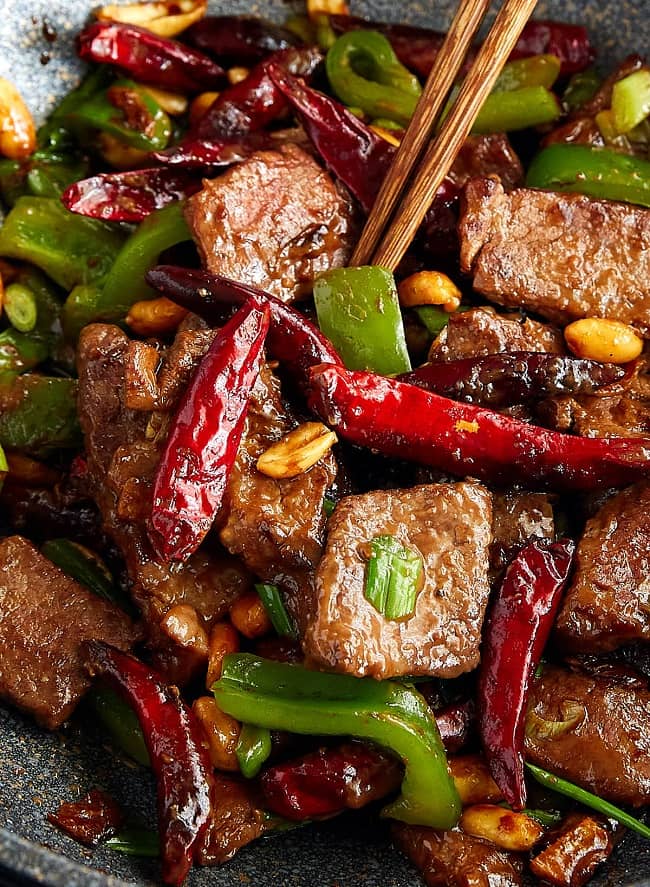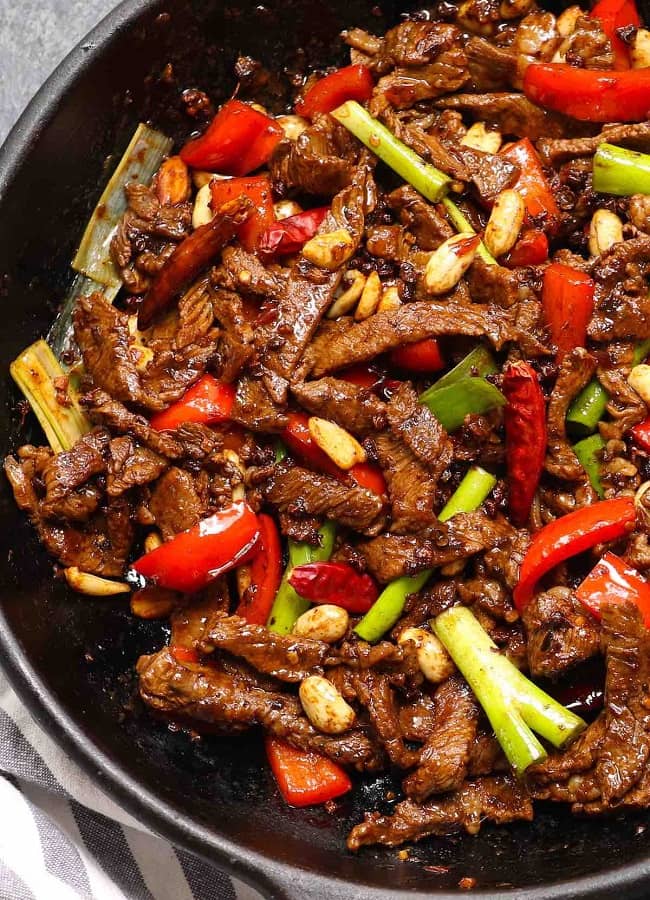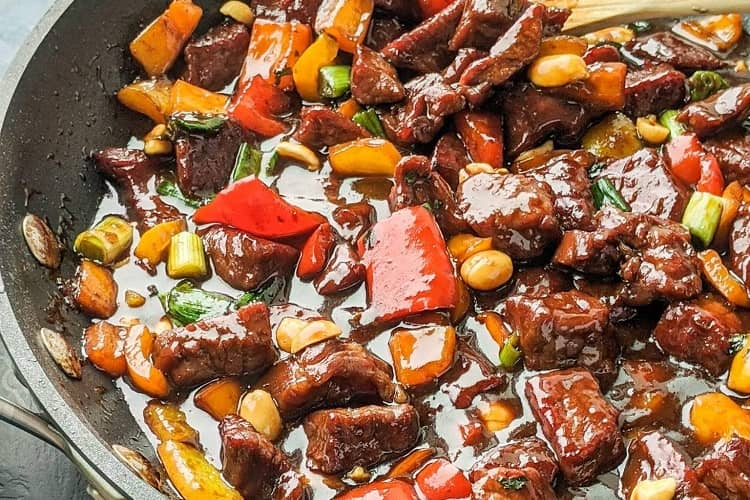This quick Kung Pao Beef is a homemade version of a popular Chinese takeout dish.
For an excellent flavor combination, the juicy flank steak is cooked in a thick and savory sauce with crisp bell peppers and crunchy roasted peanuts.
Serve this tasty chicken and veggie stir fry alone or with rice or noodles for a complete dinner.
Why Is This Recipe So Delicious?

- It’s packed with wonderful, powerful flavors! The dried red Thai chiles add a little heat, but it’s well balanced by the sweet and flavorful sauce, succulent beef, and mild bell peppers.
- Kung pao beef is simple to prepare and much simpler to make your own! One of my favorite aspects of making my favorite restaurant meals at home is that I have complete control over what goes into them and how much of each ingredient I use, ensuring that they taste exactly how I want them to. Although this recipe does not contain all of the same ingredients as a real kung pao beef, it is a compelling, easy-to-make, and very delicious at-home rendition.
- This beef meal can be served alone or with simple sides such as fried rice, white rice, or noodles. Use palmini pasta or cauliflower fried rice if you’re monitoring your carbs.
- Make this kung pao beef ahead of time to save time during the week! If you store leftovers in an airtight container, they will last for 5 days. In a large skillet, reheat it over low heat until warmed through.
Important Ingredients
Steak Flank – Around here, we love flank steak recipes! Cornstarch is the key to a truly excellent steak in your kung pao beef. Yup!
The steak strips are lightly dusted with cornstarch to tenderize the meat and protect it from the skillet’s heat. Don’t neglect this step since it keeps the steak soft and juicy.
Chinese Black Vinegar — This dark black vinegar has a sweet and smoky flavor. You can order it online or look for it in your local grocery store or international market.
Simply look for unsweetened Chinese black vinegar, which is sometimes referred to as Chinkiang vinegar or Zhenjiang vinegar.
If you can’t find Chinese black vinegar, you can use rice wine vinegar or even plain white vinegar in its place, however, the flavor will be different.
Dried Red Thai Chiles – If you’re sensitive to heat, cook with the red Thai chiles instead of eating them. Just before serving, remove them from the kung pao meat mixture.
You’ll get their flavor without the heat of eating the pepper itself. You can also reduce the number of chiles used from six to three or four.
Chef’s Advice
- To keep your steak from becoming tough and chewy, cut it against the grain (meaning perpendicular to the muscle fibers running through the meat) using a very sharp knife. It may be easier to chop the steak while it is still cold.
- Other vegetables can be added to your stir fry if desired. In kung pao beef, snap peas, broccoli, onion, or even asparagus would be delicious.
- Not a big fan of steak? You could also make kung pao chicken at home with chicken.
Don’t get distracted by the stove because the cooking procedure is quick! I like to start my sides ahead of time so that I don’t have to wait for anything once the kung pao beef is done.
Kung Pao Beef
| 15-minute prep time 10 minutes to cook 25 minutes total |
This quick Kung Pao Beef is a homemade version of a popular Chinese takeout dish.
For an excellent flavor combination, the juicy flank steak is cooked in a thick and savory sauce with crisp bell peppers and crunchy roasted peanuts. Serve this tasty chicken and veggie stir fry alone or with rice or noodles for a complete dinner.
Ingredients
- 1 pound flank steak thinly sliced
- 3 tablespoons cornstarch
- salt and pepper to taste
For the Sauce
- 3 tablespoons soy sauce
- 1 teaspoon cornstarch
- 2 tablespoons chili sauce
- 1 tablespoon granulated sugar
- 2 tablespoons Chinese black vinegar
- 1 tablespoon rice wine vinegar
For the Stir Fry
- 3 tablespoons neutral cooking oil
- 6 dried red Thai chiles
- ½ teaspoon Sichuan peppercorns
- 4 scallions of white and green parts divided, chopped
- 3 cloves garlic minced
- 1 1-inch piece of fresh ginger grated
- 1 bell pepper core and seeds removed, chopped
- ½ cup roasted peanuts
Equipment
- Large bowl
- Medium bowl
- Large skillet
Instructions For Kung Pao Beef

- In a large mixing basin, combine the meat, cornstarch, salt, and pepper. Toss or mix the beef to thoroughly coat it.
- Combine all sauce ingredients in a separate bowl. Place aside.
- Cook meat for 2 to 3 minutes in a large skillet over medium-high heat, stirring periodically, until brown.
- Set aside the steak on a plate or in a bowl. Heat the frying oil in the skillet. Add Thai chilis and Sichuan peppercorns once the pan is heated. Cook for about 1 minute.
- In a skillet, combine the white sections of the scallions, garlic, and ginger. Cook for 1 to 2 minutes, or until aromatic.
- Cook for an additional minute after adding the chopped bell pepper and peanuts to the skillet.
- Return the steak to the skillet and add the sauce mixture. Cook until the sauce becomes thick. Serve garnished with scallions’ green portions.
Notes
- If you’re managing your salt consumption, choose reduced-sodium soy sauce.
- Make careful you use Chinese black vinegar rather than a sweetened variant. You can substitute rice wine vinegar or plain white vinegar if you can’t locate it, but the flavor will be slightly different. In a pinch, balsamic vinegar would suffice, as long as it wasn’t syrupy and sugary.
- If you’re sensitive to heat, reduce the quantity of dried red Thai chilies from 6 to 3 or 4. You may also cook with the chiles, then remove them before serving so you don’t have to consume them. This will give you the taste without the heat.
- To Serve: Serve kung pao beef with white rice, cauliflower fried rice, or noodles on the side.
- Make it Added-Sugar-Free: Replace the granulated sugar in the sauce with granular Swerve.
This recipe serves around 4 people. Your desired portion sizes will determine the number of servings. The nutritional values provided are for one serving out of four, based on the components mentioned.
The exact macros will vary depending on the brands and types of ingredients utilized.
Prepare the recipe as directed to get the weight of one serving. Weigh the final recipe, then divide the weight (not including the weight of the container in which the food is stored) by four. The weight of one serving will be the result.
Nutrition Information
Serving: 1serving, Calories: 427kcal, Carbohydrates: 18g, Protein: 32g, Fat: 25g, Saturated Fat: 5g, Polyunsaturated Fat: 6g, Monounsaturated Fat: 13g, Trans Fat: 1g, Cholesterol: 68mg, Sodium: 998mg, Potassium: 706mg, Fiber: 3g, Sugar: 6g, Vitamin A: 1155IU, Vitamin C: 53mg, Calcium: 63mg, Iron: 3mg, Net Carbs: 15g
